Robots, humans can create dangerous mix
- October 1, 2025
- Posted by: Web workers
- Category: Workers Comp

Companies are installing robots at a pace faster than ever, and while the technology may eliminate dangerous work or reduce soft-tissue injuries among employees, the interaction between live workers and robots presents its own set of challenges.
Less frequent but more severe injuries will likely result from the introduction of robots more widely in workplaces, experts say.
To respond to the accelerated use of robotics, safety regulators are developing robot-related standards (see related story).
Robots have been used in manufacturing industries since the 1980s, but earlier versions were physically separated from workers, said Dawn Castillo, head of the National Institute of Occupational Safety and Health’s Center for Occupational Robotics Research in Morgantown, West Virginia.
“Around 2010 and moving forward, we saw some pretty rapid advancement of robot technology, with manufacturers designing robots that wouldn’t operate separate from workers,” she said. “These new types of technology are very exciting and hold tremendous promise for doing work that’s especially dangerous for humans. But there is the potential for injury if a human or robot unintentionally come together.” Robots are being ordered by and shipped to North American companies in record numbers, according to the Ann Arbor, Michigan-based Robotic Industries
Association, which said robot shipments to automotive companies were up 7% in 2018, compared with 2017, and shipments to nonautomotive companies were up 41%.
In the second quarter of 2019, companies ordered more than 8,500 robots valued at $446 million, said the organization, representing a growth of 19.2% over the same quarter in 2018.
At Steelcase Inc. in Grand Rapids, Michigan, robots have been on the floor in welding operations since the early 2000s. Their widespread adoption has reduced the company’s leading causes of workplace injuries — sprains and strains — because the robot can take over tasks that would require the employee to lift and twist, said Tim Martin, the company’s global health and safety supervisor.
Robots have moved beyond just the manufacturing floor, and the company is testing real-time interaction with autonomous robots in its 5G-connected workplace, and is also working on the use of robotic exoskeleton suits that employees can wear to assist with lifting and overhead work and enable them to continue to perform without the “aches and pains from normal job demands,” he said.
Robots can increase efficiencies and reduce the likelihood of sprains, strains and repetitive motion injuries suffered by workers who perform that repetitive, high-frequency work, but their introduction into the workplace could increase the severity of an injury, said Laurence Pearlman, Chicago-based senior vice president for Marsh Risk Consulting’s workforce strategies practice.
“If you get injured by a robot, it’s not going to be a sprain or strain, you’re going to have bone breakage or a fatality,” he said. “We seem to have shifted from frequency to severity when we talk about robots. The reality is, while (a robot-related injury) doesn’t happen frequently, the consequences can be really bad.”
In 2015, a warehouse dock worker was crushed by the elevated forks of a laser-guided forklift; investigators think he tried to remove some plastic wrap stuck in the machinery without initiating an emergency stop. In 2017, an automotive technician died when a manufacturing robot unexpectedly dropped a trailer hitch assembly. More recently in Washington state, a contractor’s chest was crushed between a demolition robot and a wall during an HVAC demolition, and another worker’s foot was crushed during a generator installation project.
“You really need to think about the unintended consequences and be proactive about understanding how the user interfaces with (the robot),” said Mr. Pearlman. “Things will get more automated and more autonomous … and we have to manage those risks.” And as robots continue to enter the workforce, the risks will change, said Brad Wilkins, Clearwater, Florida-based loss control manager for AmTrust Financial Services Inc.
“Sometimes (a robot) reduces hazards, risk and payroll,” he said. “If you replace workers with a robot, you also obviate the insurance. But I think what we’re going to be seeing as robots evolve is that one risk might lessen, but another emerges.”
Workers compensation costs for injury frequency and overall premium may decrease with more jobs being performed by robots, he said. But injury severity could increase and products liability insurance costs, for example, may increase if a calibration issue with a robot causes product defects.
And as the use of autonomous vehicles is adopted by companies, there will be even more potential risks to address, said Vikrum Ramaswamy, Nashville, Tennessee-based risk control manager for Safety National Casualty Corp.
“From a risk perspective, if we have an (autonomous vehicle), what type of coverage kicks in?” he said. “There’s an argument for subrogation already built in if the AV gets into an at-fault collision … are we going to see an increase in demand for cyber liabilities as well as general liabilities? We’re still trying to get our hands around these issues.”



